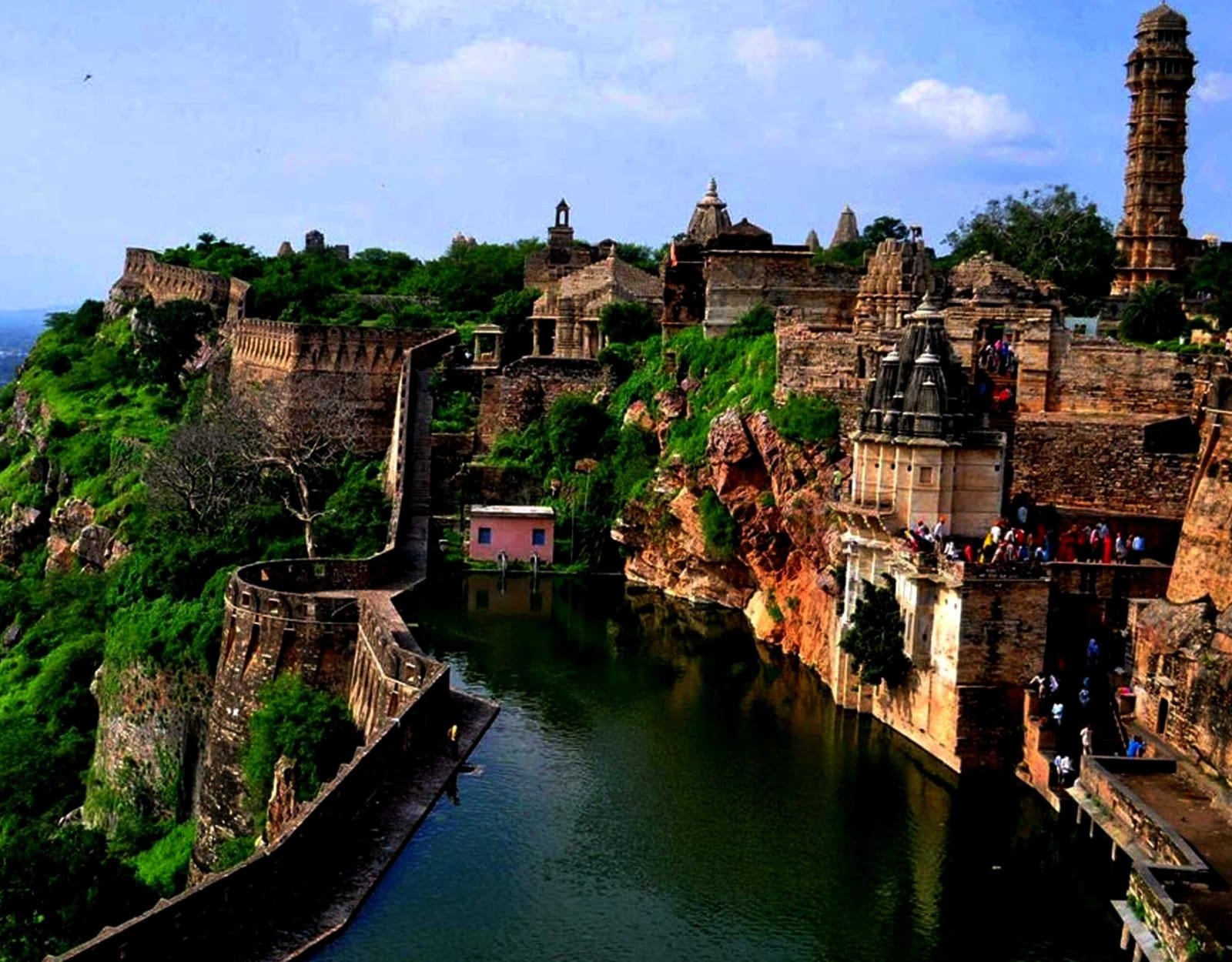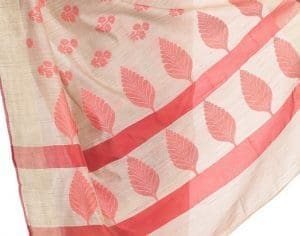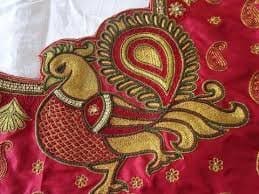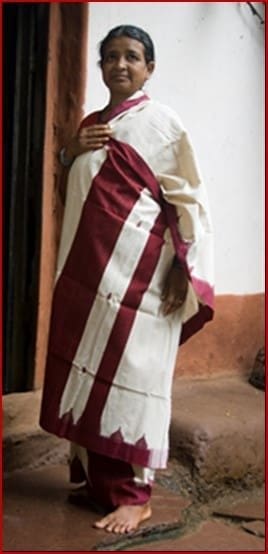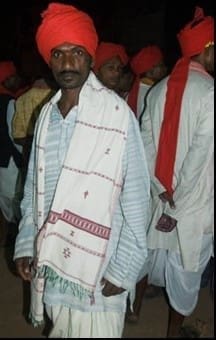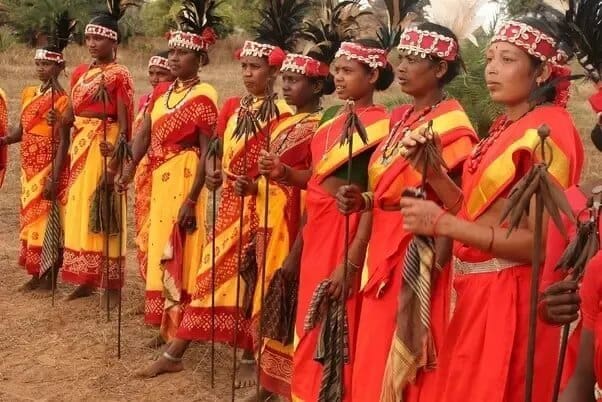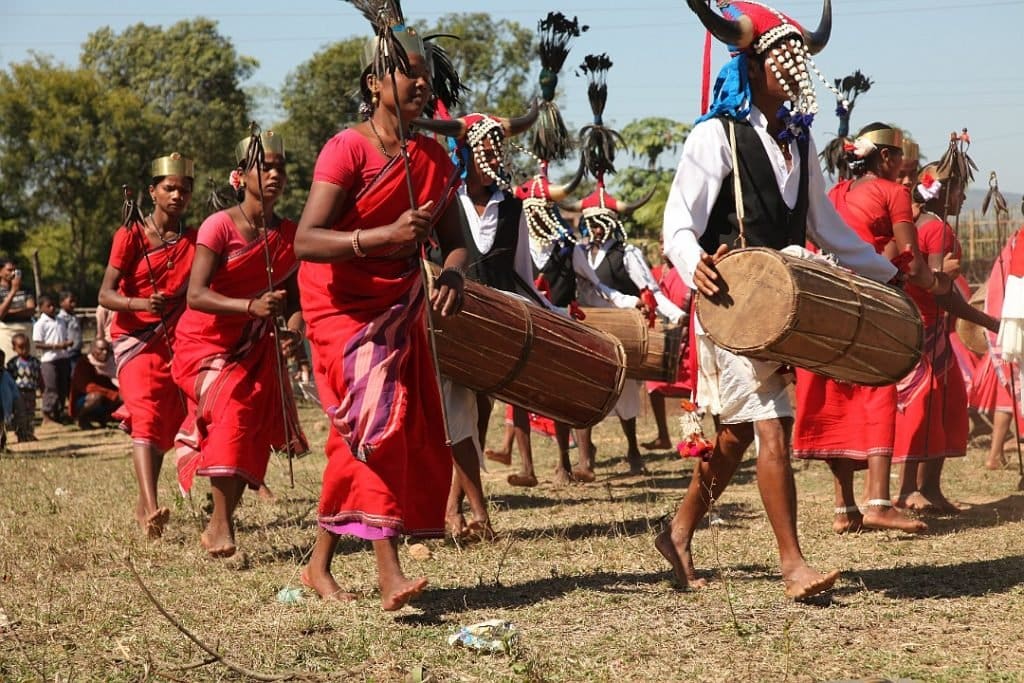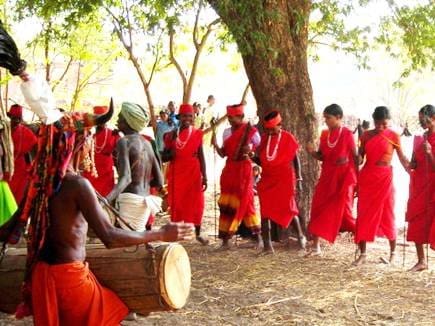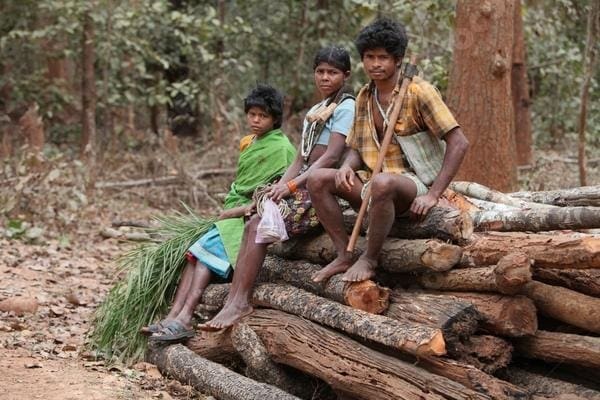Chhattisgarh is one of the 28 states of India, located in the centre-east of the country. It is the ninth-largest state in India. The textiles here are woven in heavy cotton. Keeping the public demand saris are now also being woven in finer counts as well as combination weaving of cotton and tussar. Traditional way of weaving on manual looms is followed at Bastar having motifs of birds, lions bows, animals, arrows, huts, peacocks, pitchers, temples and tribal flowers. These fabrics are worn by the tribals on the auspicious of festivals, marriages and dances.
Kosa Silk
Kosa silk is obtained from an Indian silkworm – Antheraea mylitta and is a variety of Tussar silk. It is drawn out of cocoons which are especially grown on specific trees known as Arjun, Saja and Sal. Kosa silk is known for its sturdiness and is preferred to pure silk in the state of Chhattisgarh.
Known the world over for its soft texture and purity, this version of Tussar silk is produced exclusively in India. Known for its dull golden brownish look, it is available naturally in shades of pale golden, dark honey, orange, fawn, cream and many more; all similar to the description of dull golden brown. From the original color of Kosa silk which is dull gold, the finished product is dyed using natural dyes from the palaas flower (Fire flower), the red pollen of the Rora Flower and the deep rose red from lac and some more natural contributors.
Embroidery:
The term embroidery is basically defined as the method of ornamenting a piece of clothing with needlework; or embellishment with fanciful details. Thus embroidery is regarded as the art of decorating textiles using a needle and thread. Embroidery of Chhattisgarh has earned its fame because of the versatility of creations by the artisans. The artisans of Chhattisgarh use an array of stitches that are used to decorate the items. The most important centres of embroidery work of Chhattisgarh are located in the Baster regions and are admired for the creative excellence. The embroidery of Chhattisgarh is one of the main sources of income for different other communities. Today, even though embroidery is amongst the most traditional methods of decorating clothes, it is still as popular. Designs may date back to ancient times, or the modern geometric modern day designs, but all the same embroidery continues to be one of the common ways of decorating clothes. In fact, specialists feel that today, there is much more scope for creativity and innovation, because of the acceptance level.
Ari embroidery of Chhattisgarh has its international market in Nigeria where women drape themselves (during ceremonial occasions) in the embroidered cloth from this region. This has ornamentation of tikris and beads, which make them, look attractive. This type of embroidery is done on a frame of wooden beams. The fabric is worked upon with a long needle, threads, tikris and beads. Multi sized frames are used, usually about 1.5 feet high, to secure the cloth on which the design is sketched with a stencil. One hand secures the thread under the cloth to the needle while the other hand moves the needle on top of the cloth with ease. Decorative tikris and beads are attached to the cloth with the needle.
Another embroidery pattern is the jaali or net embroidery in geometric or floral shapes and is done by pulling the warp and weft threads and fixing them with minute buttonhole stitches. The finished products dominantly comprise items for household use like curtains, bedspreads, furniture covers and dress material.
Costumes of Chattisgarh:
Pata: A pata is a draped textile like a sari. The background is off-white with aal-dyed red borders and extra weft ornamentation. Some patas are for routine wear whereas certain designs, placement of motifs and methods of draping differ for ceremonial or special occasions. Usually a pata is around–fourr meters long and one-meter-wide and is made of low count coarse cotton yarn of 10s, 14s or 20s.
Tuvaal: It is a piece of fabric used as a shoulder cloth by men in Bastar. It is three feet wide and six feet long. It is generally folded and draped on the shoulder but is wrapped like a shawl in cold evenings. For festivals and ceremonies, tuvaals with ornamentation are preferred. Most often the base is off white, ornamented with aal-dyed red yarn in extra weft to create motifs inspired from nature.
Picchori: It is the lower garment for men, draped like a wrap-around dhoti. The dulha picchori is a special ornamented shaal -like fabric which is worn by a bridegroom.
Shaal: The length and width of shaal varies but most often it is one-meter-wide and around two meters long. Shaals meant for ceremonies or festivals are woven with aal-dyed red yarn as the base colour and extra weft ornamentation in off-white.
Chaddar: Like tuvaal and shaal, it is 45 inches wide and 90 inches long. Men also wear it around the neck or like a sheet to protect themselves from heat or cold.
Chaptati: It is a running fabric woven using alternate red and white yarn in warp as well as weft to create checks. The width of the fabric is either 36 inches or 42 inches. It looks like a fine woven mat (chatai) and is used for making kurta, baniyan (undershirt), bandi (sleeveless short jacket), etc.
Angoccha/Angocchi: It is a short length of narrow width fabric which is generally placed on the shoulder. These are used to cover the head in the sun. Angoccha is also sometimes known as angocchi. It has fine red line borders running weftwise and one-inch-wide red bands on the two ends, pallu.
Dhoti: It is a plain length of white fabric with a fine red edge, worn or draped as a lower garment in varied styles by men all over India. A kurta is worn with the dhoti and the angoccha for special occasions. Otherwise readymade cotton or cotton- and- synthetic-blended shirts are worn with the dhoti and angoccha, while going out.
Kansbandhi: It is an ornamental dhoti length of textile woven with wide aal-dyed ends or pallu and off-white central field. It has many motifs woven on the body as well as on the borders and pallu. In Bastar, men wrap the kansbandhi around the waist while dancing.
Phenta: It is around three and a half meters long and approximately 15–18 inches wide fabric which is tied around the head by men like a turban. It is generally ornamented and is worn on special occasions.
Tribes of Chhattisgarh
With almost one-third of its population belonging to the tribes, Chattisgarh can be easily touted as a hot destination for Tribal Tourism. Each of the tribes here follows a unique lifestyle, tradition and rituals distinct from every other tribe. While most of them settle in dense forest areas, a lot of tribes are located in various regions of Bastar district, thus accounting for over 70 percent of the district population.
The major tribal groups are as follows:
Gond Tribe:
The tribe derives its name from the Telugu word ‘Kond’ which means ‘hill’. Living mainly in dense forests of Bastar district, Gonds are primarily hunters and agriculturists. They are one of the largest and oldest tribe in the state and popular for their ‘Ghotul System’ of marriage.
Bison Horn Maria Tribe:
Mainly getting their name from their traditional head gear they wear during their rituals and dances, this tribe is settled on the south of Indravati River in the state. The tribe worships earth as a deity and so resort to produce they can get from forests and agriculture for their survival.
Dhurvaa:
Also situated in the Bastar district, this tribe is highly caste conscious and follows social code of conduct with the communities of equal status. The women love to adorn themselves with beads and handmade jewelry. The tribe mainly relies upon agriculture and selling articles made of cane.
Dorla:
Found in Dantewada, this tribe likesto wear clothes at its minimal. Beaded jewelry and braided locks which are called Khosa. Mostly non-vegetarian, their diet mainly comprises of rice, palm-tree licquor, Kosra and Madiya. They celebrate festivals round the year and instill high faith in spirits, often reflected in their traditions.
Abhuj Maria:
This happens to be one of the oldest tribes in Chattisgarh which still abides by its rules and traditions and is cut-off from the modernistic adaptations other tribes have witnessed over the years. Settled in Abhujmar forests, the tribe keeps no contact with the other social communities and are known for their aggressive nature. They don’t like to cover themselves in anything more than the lion cloth and mainly resort to hunting for their survival.
Arts & Crafts of Chhattisgarh
Cotton Fabrics
Cotton Fabrics are one of the famous and attractive handicrafts made by the tribals of Bastar. These are made of Kosa thread which is made from a kind of worm found in the forest, hand woven and hand printed by tribes who trace their lineage to the 14th century weaver-saint-poet Kabir. The hand printing is generally done with the natural vegetable dye extracted from ail, found in the forest of Bastar. These fabrics include cotton saris – well-known as Bastar Kosa Saree, dress materials and drapes.
Bamboo Art
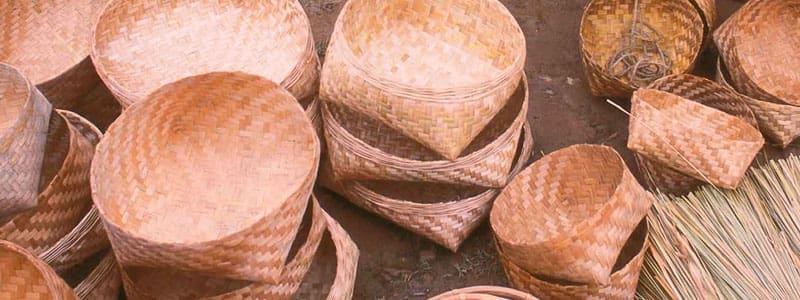
Bamboo thickets are common sight in the State and tribals of Chhattisgarh have been putting their craftsmanship to work. Craftsmanship of Chhattisgarh tribals can be seen from varying articles of craft produce they make out of bamboo. Articles for daily as well as decorative use are produced by these artisans. Some of the well known Bamboo produce include agricultural implements, fishing traps, hunting tools and baskets.
Bell Metal (Dhokra)
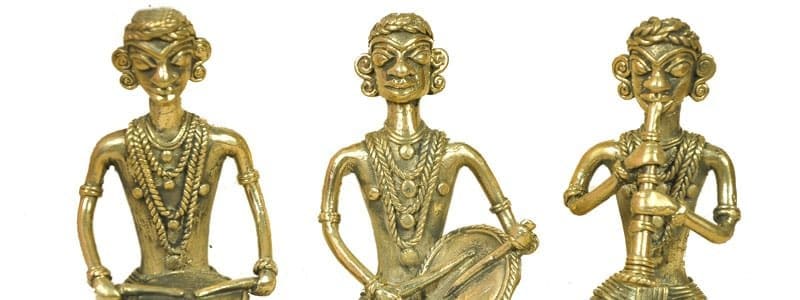
Bastar and Raigarh districts of Chhattisgarh are popular for crafting bell metal handicrafts using brass, and bronze. Tribes like ‘Ghawas’ of Bastar and ‘Jharas’ of Raigarh mainly practice this art form, also known as Dhokra art. This is done with lost wax technique or hollow casting.
Godna
Godna is possibly the most pioneering art form, currently practiced by a handful of women in Jangala in Chhattisgarh. Ladies of this village paint traditional tattoo motifs on textiles. They use natural color obtained from the forest and combine them with acrylic paint to make it more stable on fabric.
Wrought Iron (Loha Shilp)
The Loha Shilp or the use of wrought iron to create dark raw forms of the metal artifacts and figurines is another craft form of Chhattisgarh. The raw material used for this craft is mostly recycled scrap iron. Things like lamps, candle stands, effigies of musicians, toys, figurines, and deities are the typical products made out of this craft.
Ornaments
Jewelry from Chhattisgarh is available in a variety of gold, silver, bronze and mixed metal. Ornament made out of beads, cowries and feathers are part of tribal costumes. Tribal men and women wear traditional ornaments.
Terracotta

Like in many other states, Terracotta has found a place in the handicrafts created by Chhattisgarh. Terracotta pottery represents the rituals and customs of tribal life in the state and symbolizes their emotions.
Tumba
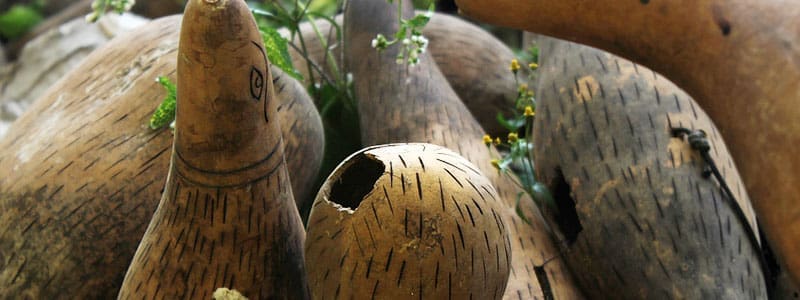
Tumba is a less known craft widely produced in the Bastar region, which originated with the widespread use of hollow gourd shells. Tribal use them as containers to store water and salfi, from which this art is inspired.
Wall Painting
Traditional wall paintings of the State are associated with rituals. Floors and walls are painted with colors and in almost every instance the depiction being associated with some ritual. Pithora paintings are a common traditional art form. These paintings originated in the tribal area of the Central India which is presently Madhya Pradesh and Chhattisgarh and depicts the offering to gods. These paintings are usually done on the occasion of marriages, childbirth and other occasions of fulfillment of wish etc. Most of these paintings have a horse as it was considered auspicious to sacrifice a horse. In most of these tribal houses one can find Pithora paintings. They are colorful and use natural colors.
Wood Carving

The woodcarving art has been flourishing in Chhattisgarh from time immemorial and one can find beautifully carved wooden products designed by the craftsman of the State. The skillful craftsmen of the State carve beautiful wooden Ceilings, doors, lintels etc using different kinds of wood like shisham, teak, dhudi, sal and kikar. The craftsmen also make pipes, masks, doors, window frames and sculptures.
Reference
https://www.craftandartisans.com/tribal-textiles-of-chhattisgarh.html
https://www.chhattisgarhtourism.co.in/arts-and-crafts-of-chhattisgarh.html
https://www.craftclustersofindia.in/site/index.aspx?Clid=507
https://www.hltt.in/india-tribes/chhattisgarh.html
https://www.chhattisgarhtourism.co.in/arts-and-crafts-of-chhattisgarh.html

Ms. Sidrah Mubin Patel. B.Sc. in Textiles and Apparel Designing, Sir Vithaldas Thackersey College of Home Science.
Textile Value Chain Intern. Email: tvcmedia.digital@gmail.com

